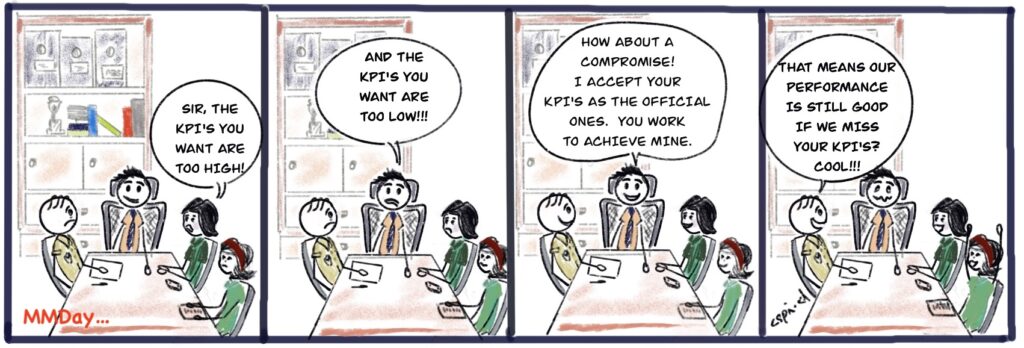
KPIs are widely used by companies. My experience with developing KPIs together with staff and the wide experience of Managers, Middle and Senior as well as individuals suggests that sandbagging is a major constraint to better results.
What is sandbagging?
Researching the origin resulted in confusion with two common factors generally agreed. The first was “creeping up on someone and hitting them from behind with a bag filled with sand’. This was considered as cheating. And ‘cheating’ is the second. There is an element of cheating in sandbagging.
Examples provided on the Internet range from cheating in poker by holding back from betting, even though you have a good hand, to get the pot to grow, to holding back reporting sales to surprise the boss when it counts, or to push the sales to the next quarter to make life easier. Over all, basically, it’s the idea of “under-promise and over-deliver.”
With KPIs the sandbagging is more about ‘under promise’ to not get a poor performance ranking!
This is where the problem comes in, as the motivation is not ‘to over deliver’. Managers know that the discussions around KPIs are more about reducing the size of the measure in order not to fail, than to surprise with overachievement.
In a world where a KPI achieved is considered as excellent, whether it was sandbagged or not, all employees are chasing a measure that is less than the company deserves.
Consider the following: In a company with 2000 employees all of whom win arguments for a KPI lower than they are being pushed towards. Let’s say that the sandbagging amounts to 5% on average. This means that the results of 2000 employees will be judged by a measure that is less than what should be by 5%. Every employee is being measured on under-performance.
Managers, generally, compromise on KPI measurements. Those few who insist on a higher KPI run the risk of demotivating the employee or even causing them to think of leaving for a better job, such is the fear of getting a poor performance score.
How to solve this sandbagging challenge?
Here are some ideas:
– See KPIs as the minimum achievement expected. You let the employe know that you accept the KPI measure BUT that the real target you are expecting from them is greater (mentioning a number).
Let me share when I first learned the power of this. In South Africa I was a member of the management team for a public company. We had just hd a new Managing Director (CEO equivalent) appointed. We, as a team , had just completed the annual plan for the company which was due to be presented to the Board the following week. The new MD was presented with the plan on his first day on the job. A key number was ROAM (Return on Assets Managed). We presented 11%! He said that was unacceptable and to take the week to revisit the plan. We did and came back on the Friday with 13% ROAM.
After we presented it he said “OK I will present that to the Board, but I am looking for a ROAM of 25%”, pause, “and I have no idea how to do that”, pause, “so we will all have to learn!”. And learn we did. The first year we delivered a ROAM of 18%. Three years later we were at 32%.
As a manager, argue on the first KPI proposal presented. Accept the second and at the same time name the real KPI you want to see achieved. At this point the manager will say whatever is authentic, such as, ‘and I will ensure you getting the training to achieve that” or “I will coach you on ways to achieve that” or “we will, as a team, have to learn how to get that level of result”.
And then deliver on the what you promised and keep the ‘real KPI’ front and centre.
– Change the way that KPIs are written. Many KPIs are actually SLAs, especially for individual workers. % errors, % throughput, % satisfaction are some of these measures. A KPI for paying suppliers on time might be 95%. That is likely better than the previous year. Does the manager really want you to NOT pay suppliers on time 5% of the time. If a company gets 10,000 invoices to pay in a quarter does that mean you are OK with annoying suppliers 500 times? Naturally you would like 100% invoices paid on time. And that is the way you want all the employees in the payments department to think.
What managers can do with all SLA type KPIs is write them as follows:
Objective: Pay suppliers on time and accurately 100% of the time.
KPI: Pay suppliers at least 95% on time.
This keeps front and centre that 100% is what you want. How to go from 95% to 100% is the focus of the payables department.
Any KPI measure that is different from the real KPI can be written in this way.
– We all know that things change frequently. The idea that a KPI must be unchangeable for the full year does not make sense. But the unchangeability is important in a world where an employee’s performance review score is dependent on it.
See KPI’s as a trend indicator to which the employee is working. Take the measurement frequently and watch the trend and use the results as a basis for frequent informal check-ins and coaching. Using the 95% measure above for supplier payments, trend whether this is on track, or has already been achieved, or is going down. In each case the manager takes different action:
– On track. It is looking good for the KPI but not for the 100% objective. Where can we be doing better?
– Already achieved. Well done and how to we do even better to achieve the objective? Let’s change your KPI to 97%.
– Going down. What is the root cause of this happening? Let’s work to solve it.
It is possible that something happens to make a specific KPI impossible to achieve. For example, a company stops making a product that is a top seller because of regulation changes.
In these few instances it makes sense to recalibrate the measure for sales.
– Finally, consider during quarterly check-ins to agree with the employee the one to three results that you want them to achieve in the next quarter. The results will be something that moves the needle on the KPI measures. If, for instance, you find that incomplete documents coming into payables is a root cause of delays in some payments being made on time. A result you might agree on is for the employee to investigate the sources of incorrect documents and possible reasons. This, in turn, will lead to future actions to ensure documents are complete when reaching payables. This focus on what do we need to do to make KPIs more likely to be achieved or over achieved is management at its finest.
Final words
Sandbagging KPIs can collectively drop a company’s results by quite a high percentage due to the universal reality of it occurring.
As a manager work hard to make the KPI process as painless as possible for both you and the employee by limiting the arguments to get a ‘real’ measure. At the same time make that ‘real’ measure known and visible.
In the story above, we did not even celebrate when, in the second quarter, we reached 15% because we were chasing 25%. This in spite of the fact that bonuses were based on achieving 13%.

Make sure that your real objectives are seen as targets to which you are truly committed. They should not be seen as pie in the sky.
‘Pie is the sky’ is an American phrase coined by Joe Hill a Swedish-born itinerant labourer who migrated to the USA in 1902 and wrote songs supporting labour activists. It refers to making promises that are in the future and unlikely to come to fruition.
